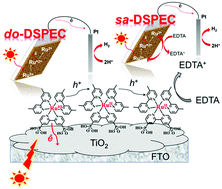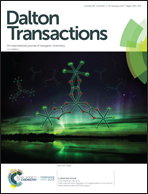Factors influencing the photoelectrochemical device performance sensitized by ruthenium polypyridyl dyes†
Abstract
The dye-sensitized photoelectrochemical cells (DSPECs) incorporating a family of ruthenium complexes [RuII(bipyP)(bipy)2] (P1), [RuII(bipyP)(dmb)2] (P2), [RuII(bipyP)(dtbb)2] (P3) and [RuII(bipyP)(dnb)2] (P4), where bipyP = 2,2′-bipyridine-4,4′-diphosphonic acid, bipy = 2,2′-bipyridine, dmb = 4,4′-dimethyl-2,2′-bipyridine, dtbb = 4,4′-di-tert-butyl-2,2′-bipyridine, and dnb = 4,4′-dinonyl-2,2′-bipyridine, were fabricated in a dye-only system (do-DSPEC) and in a system where the electrolyte solution was loaded with EDTA sacrificial agent (sa-DSPEC). The increasing number of the alkyl chains of the ancillary bipy ligand shifts the ground- and excited-state potentials to the more negative values, although the introduction of the longer nonyl chain in P4 shows the opposite effect. In do-DSPECs, the photocurrent and hydrogen production performance follows the order P4 > P3 > P2 > P1, which correlates well with the degree of the excited-state quenching by electron injection to the conduction band of TiO2. The photoelectrochemistry of the sa-DSPECs reveals 10 times as many photocurrents as that measured in do-DSPECs, suggesting the ability of the hole to oxidize EDTA molecule. The hydrogen production performance of sa-DSPECs over five hours follows the order P2 > P1 > P3 > P4, which is consistent with the RuIII/RuII reorganization energies and the hole mobility on the TiO2 surface. The present study provides evidence that the subtle alkyl chain variation of the ruthenium photosensitizers can fine tune the electron injection capacity, RuIII/RuII self-exchange energetics and photostability of the complexes, which significantly influence the performance of the DSPECs.



 Please wait while we load your content...
Please wait while we load your content...